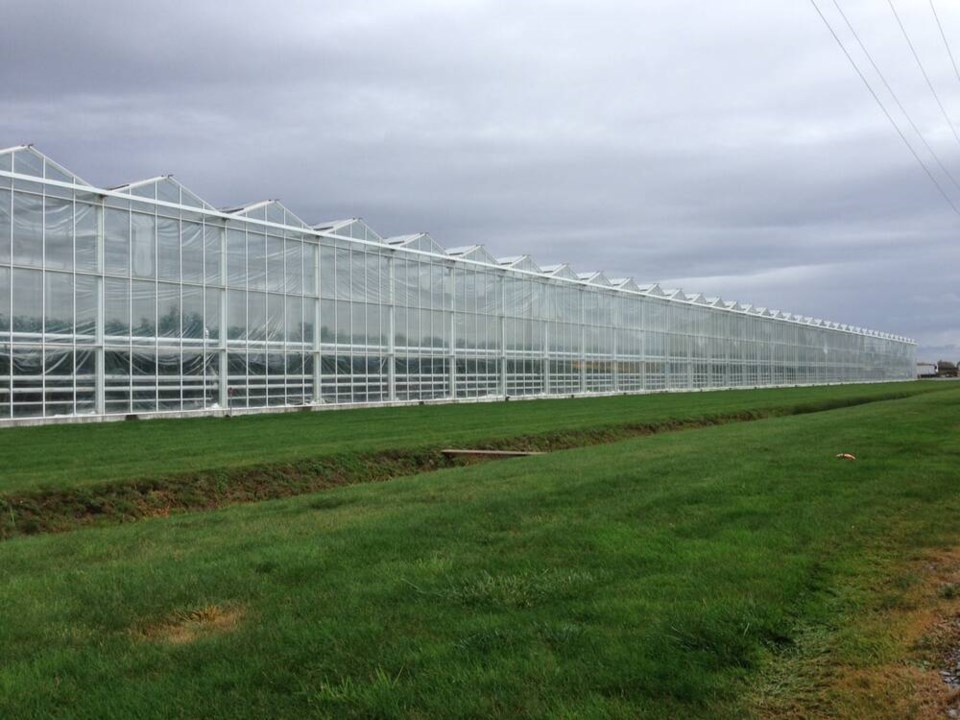Greenhouses in Delta will have to pay their share of development cost charges (DCCs).
Council recently gave preliminary approval for a new set of DCC’s, which help fund transportation, water, sanitary sewer, drainage and parks projects needed to support the additional demands generated by new residential, commercial, institutional, industrial and agricultural development.
A staff report notes that the Delta Farmers’ Institute (DFI) expressed concern that the intensive agriculture DCC rate increase was significantly higher than the other land categories in some instances.
The DFI generally supported the change in the way DCCs would be calculated, moving from a gross site area calculation, which includes parking and other exterior components to a gross floor area calculation, which only charges for the building area.
“However, there were concerns that the proposed rate increase could have a disproportional impact on the agricultural community compared to the other land uses, especially for large greenhouse operations, produce washing facilities, and livestock operations,” the report noted.
Those concerns were reiterated by Coun. Alicia Guichon at council’s Dec. 11 meeting, saying she feels there needs to be more discussion when it comes to the definition of intensive agriculture.
She noted Delta is one of the only cities to charge an agricultural DCC and that there was a feeling in the farming community that greenhouses were being unfairly targeted.
Deputy City Manger Marcy Sangret responded that Delta has been charging a DCC for intensive agriculture since 2001, and it had been acknowledged at the time that certain types of agriculture are more intensive and can burden municipal services including water and drainage.
Noting not all agricultural uses are charged DCCs, such as barns, Sangret said the charges apply to not only greenhouses, but also livestock facilities as well as manufacturing and processing of products, but at much lower rates than commercial or industrial manufacturing operations.
Although the DFI suggested the growing areas within greenhouses be excluded, staff decided that option would not reflect the actual impact of those buildings on Delta’s infrastructure, she added.
Through discussions with the DFI regarding projected agricultural growth, rainwater capture efficiencies, storm water retention and limited road impact with employees often living onsite, staff recommended that the proposed intensive agriculture DCC rate be reduced from what was originally proposed.
As a result, the city lowered the proposed rate by 12 per cent from the current intensive agriculture DCC rate in year one, with a 20 per cent municipal assist factor, and then increase it by 19 per cent from the current rate thereafter, with a one per cent municipal assist factor.
A report last year on the city’s draft Agricultural Plan noted that in 2010, there were 152 hectares under glass greenhouses and 11 hectares under polyethylene structures. In 2016, there were 179 hectares under glass greenhouses and 10 hectares under polyethylene structures. The crops grown within the greenhouses are primarily vegetable vine crops such tomatoes, sweet peppers, and cucumbers, as well as strawberries, propagation/nursery services and cannabis.
“Since the legalization of cannabis in 2018, there have been expansions and contractions within that industry locally. Some existing greenhouses have converted to cannabis production and new greenhouses have been constructed for cannabis production, while conversely more recently some cannabis greenhouses have reverted back to growing fruit and vegetables. This fluctuation points to the fluidity of these commodities and the ability of Delta operators to shift production with market demand,” the report notes.




